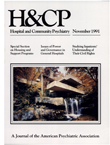Comparison of Outcomes for Clients Seeking and Assigned to Supported Housing Services
Abstract
As part of state-supported interventions to reduce risk of rehospitalization, seriously disabled psychiatric patients who had been involuntarily hospitalized twice in the previous three years were assigned to receive supported housing services in an Oregon community. Compared with 22 voluntary clients in the same supported housing program, the 21 involuntary (assigned dients rated higher on risk factors such as history of suicide attempts, self-neglect, homelessness, and medication noncompliance. The involuntary dients showed a much higher utilization of supported housing services and case management, psychiatric, and shelter services during the nine months after entry into the program, and they had a higher one-year rehospitalization rate. However, they used substantially fewer inpatient days in the six months after entry in the program than in the six months before.
Access content
To read the fulltext, please use one of the options below to sign in or purchase access.- Personal login
- Institutional Login
- Sign in via OpenAthens
- Register for access
-
Please login/register if you wish to pair your device and check access availability.
Not a subscriber?
PsychiatryOnline subscription options offer access to the DSM-5 library, books, journals, CME, and patient resources. This all-in-one virtual library provides psychiatrists and mental health professionals with key resources for diagnosis, treatment, research, and professional development.
Need more help? PsychiatryOnline Customer Service may be reached by emailing [email protected] or by calling 800-368-5777 (in the U.S.) or 703-907-7322 (outside the U.S.).



